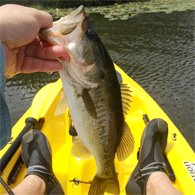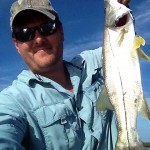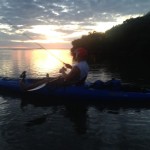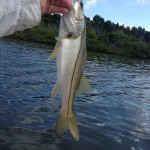
Snook are widely rearguard as one of the most exciting game fish to catch from a kayak. They range in size from only 12″ to over 50lbs. Snook are also one of the most coveted fish on the dinner table, the main reason for its restrictive regulations.
There are many anglers who claim that Snook do not live in Mosquito Lagoon, but they most certainly do, and the do in fairly large numbers. The trick is knowing when and where to find them, and what to use to catch them.
Where to find Snook
Snook are not often found out in the open flats of Mosquito Lagoon where the Trout and Redfish are found. Snook like to relate to cover, and because of this preference they are most frequently found around the mangrove shorelines.
The most productive areas are mangrove shorelines where the branches hang over water that is at least 12″ deep, with deeper water being better. Snook will often be found hiding in the shadows of the mangrove branches waiting to ambush any prey that comes near them.
Snook are also sensitive to temperature swings. They are not often found in Mosquito Lagoon during the colder months but can be found in decent numbers starting in late March – November.
Equipment to catch Snook
The average Snook caught on Mosquito Lagoon is under 10lbs, so the usual stout gear used for catching Snook is not required. Because of their preferred habitat (the mangrove shorelines) ultra light equipment will not work. A strong spinning real spooled with 12-15lb braid and a 20lb fluorocarbon leader on a medium action rod will be able to convince most Snook on the lagoon to come out away from the mangroves! This same set up can be used to catch most fish that are found in Mosquito Lagoon.
How to catch Snook
Snook are very similar to freshwater Large Mouth Bass in what they will attack, and are willing takers of artificial lures and live bait alike.
Once a mangrove shoreline is located, a great method to catch Snook is to set up a drift parallel to the shoreline. Cast your lure/bait right under the branches that overhang the water and slowly work the lure back to the Kayak. Most hits will occur while the lure/bait is falling or early in the retrieve. Snook hit very hard, and once hooked will run for cover.
Once a Snook is hooked it is important to pull them away from the mangroves. Snook have a natural instinct the hide in the cover when threatened and if not pulled away from cover they will either cut the line or foul it in the root structure.
Artifical Lures
Snook are very well known for their acceptance of artificial lures. They are caught on everything from top water plugs to soft plastics and even crank baits.
Early in the morning or just before sunset top water plugs are great lures for Snook. Cast the top water parallel to the mangrove shoreline, about 5 feet from the over hang. Work the plug back to the kayak. In the morning/evening Snook feel more secure and will come out from cover to attack the plug. Upon hooking a Snook quickly push the kayak away from the Mangroves and bring the Snook Along.
Through out most of the day and night soft plastic baits are the most consistent for catching Snook on Mosquito Lagoon. A popular bait is a soft plastic jerk bait. Cast the jerk bait under the mangrove overhang. Allow it to slowly fall to the bottom (many hits will happen while the lure is falling) and the begin to slowly work it back to the kayak. With the bait rigged in a weedless fashion a decent amount of pressure is required to set the hook properly, so be sure to set the hook with a rapid sideways motion (upward may cause your line to tangle in the mangroves).
Live Bait
When Kayak Fishing for Snook on Mosquito Lagoon live bait can be quite successful. Live pinfish, croakers and jumbo shrimp are great live baits, and even some cut baits may work if presented on a jig head and worked along the cover.
Using a circle hook, free line the bait right at the edge of or just bellow the mangrove overhangs. Snook will strike live bait aggressively, and often times will do so just as the bait is entering the water.
Florida Snook Regulations
- Snook regulations are ALWAYS changing in Florida make sure to check out the FWC for the most recent info
- http://myfwc.com/fishing/saltwater/recreational/snook/





Comment here